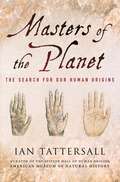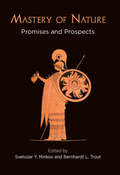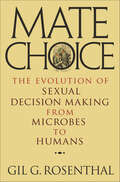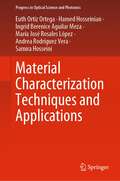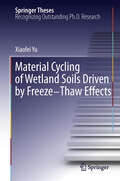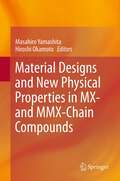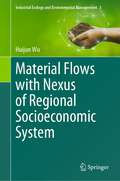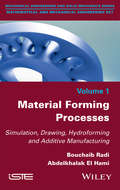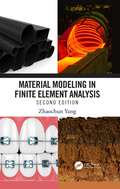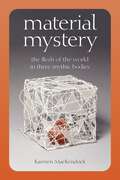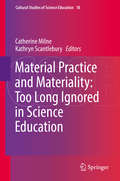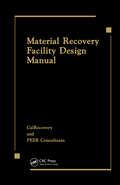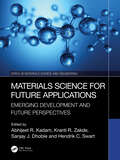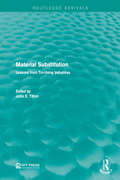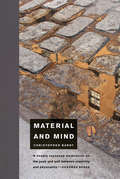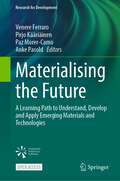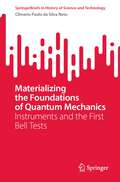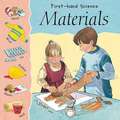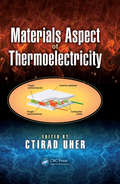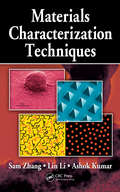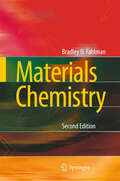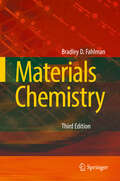- Table View
- List View
Masters of the Planet: The Search for Our Human Origins
by Ian TattersallIan Tattersall takes us deep into the fossil record to uncover what made humans so special. Surveying a vast field from initial bipedality to language and intelligence, Tattersall argues that Homo sapiens acquired a winning combination of traits that was not the result of long term evolutionary refinement. Instead it emerged quickly, shocking their world and changing it forever.
Mastery in primary science (Exploring the Primary Curriculum)
by Deborah Wilkinson Wayne StallardWhat does 'mastery' look like in primary science? How can teachers plan for, assess and evidence it? This book explores how ‘rich’ learning tasks that enable children to apply, analyse, evaluate, and/or create to solve exciting and novel problems support the development of mastery level knowledge and skills in primary science. - Outlines how to recognise and use assessment opportunities - Focuses on the development of conceptual understanding - Highlights and demontrates the importance of teacher questioning - Explores the theories behind 'mastery' for primary science
Mastery in primary science (Exploring the Primary Curriculum)
by Deborah Wilkinson Wayne StallardWhat does ′mastery′ look like in primary science? How can teachers plan for, assess and evidence it? This book explores how ‘rich’ learning tasks that enable children to apply, analyse, evaluate, and/or create to solve exciting and novel problems support the development of mastery level knowledge and skills in primary science. - Outlines how to recognise and use assessment opportunities - Focuses on the development of conceptual understanding - Highlights and demontrates the importance of teacher questioning - Explores the theories behind ′mastery′ for primary science
Mastery of Nature: Promises and Prospects
by Svetozar Y. Minkov Bernhardt L. TroutIn the early modern period, thinkers began to suggest that philosophy abjure the ideal of dispassionate contemplation of the natural world in favor of a more practically minded project that aimed to make human beings masters and possessors of nature. Humanity would seize control of its own fate and overthrow the rule by hostile natural or imaginary forces. The gradual spread of liberal democratic government, the Enlightenment, and the rise of technological modernity are to a considerable extent the fruits of this early modern shift in intellectual concern and focus. But these long-term trends have also brought unintended consequences in their wake as the dynamic forces of social reason, historical progress, and the continued recalcitrance of the natural world have combined to disillusion humans of the possibility—even the desirability—of their mastery over nature.The essays in Mastery of Nature constitute an extensive analysis of the fundamental aspects of the human grasp of nature. What is the foundation and motive of the modern project in the first place? What kind of a world did its early advocates hope to bring about? Contributors not only examine the foundational theories espoused by early modern thinkers such as Machiavelli, Bacon, Descartes, and Hobbes but also explore the criticisms and corrections that appeared in the works of Rousseau, Kant, Nietzsche, and Heidegger. Ranging from ancient Greek thought to contemporary quantum mechanics, Mastery of Nature investigates to what extent nature can be conquered to further human ends and to what extent such mastery is compatible with human flourishing.Contributors: Robert C. Bartlett, Mark Blitz, Daniel A. Doneson, Michael A. Gillespie, Ralph Lerner, Paul Ludwig, Harvey C. Mansfield, Arthur Melzer, Svetozar Y. Minkov, Christopher Nadon, Diana J. Schaub, Adam Schulman, Devin Stauffer, Bernhardt L. Trout, Lise van Boxel, Richard Velkley, Stuart D. Warner, Jerry Weinberger.
Mate Choice: The Evolution of Sexual Decision Making from Microbes to Humans
by Gil G. RosenthalA major new look at the evolution of mating decisions in organisms from protozoans to humans The popular consensus on mate choice has long been that females select mates likely to pass good genes to offspring. In Mate Choice, Gil Rosenthal overturns much of this conventional wisdom. Providing the first synthesis of the topic in more than three decades, and drawing from a wide range of fields, including animal behavior, evolutionary biology, social psychology, neuroscience, and economics, Rosenthal argues that "good genes" play a relatively minor role in shaping mate choice decisions and demonstrates how mate choice is influenced by genetic factors, environmental effects, and social interactions.Looking at diverse organisms, from protozoans to humans, Rosenthal explores how factors beyond the hunt for good genes combine to produce an endless array of preferences among species and individuals. He explains how mating decisions originate from structural constraints on perception and from nonsexual functions, and how single organisms benefit or lose from their choices. Both the origin of species and their fusion through hybridization are strongly influenced by direct selection on preferences in sexual and nonsexual contexts. Rosenthal broadens the traditional scope of mate choice research to encompass not just animal behavior and behavioral ecology but also neurobiology, the social sciences, and other areas.Focusing on mate choice mechanisms, rather than the traits they target, Mate Choice offers a groundbreaking perspective on the proximate and ultimate forces determining the evolutionary fate of species and populations.
Material Balances for Chemical Reacting Systems
by S. Whitaker R.L. Cerro B.G. HigginsWritten for use in the first course of a typical chemical engineering program, Material Balances for Chemical Reacting Systems introduces and teaches students a rigorous approach to solving the types of macroscopic balance problems they will encounter as chemical engineers. This first course is generally taken after students have completed their studies of calculus and vector analysis, and these subjects are employed throughout this text. Since courses on ordinary differential equations and linear algebra are often taken simultaneously with the first chemical engineering course, these subjects are introduced as needed. Teaches readers the fundamental concepts associated with macroscopic balance analysis of multicomponent, reacting systems Offers a novel and scientifically correct approach to handling chemical reactions Includes an introductory approach to chemical kinetics Features many worked out problems, beginning with those that can be solved by hand and ending with those that benefit from the use of computer software This textbook is aimed at undergraduate chemical engineering students but can be used as a reference for graduate students and professional chemical engineers as well as readers from environmental engineering and bioengineering. The text features a solutions manual with detailed solutions for all problems, as well as PowerPoint lecture slides available to adopting professors.
Material Characterization Techniques and Applications (Progress in Optical Science and Photonics #19)
by Samira Hosseini Euth Ortiz Ortega Hamed Hosseinian Ingrid Berenice Aguilar Meza María José Rosales López Andrea Rodríguez VeraThis book presents commonly applied characterization techniques in material science, their brief history and origins, mechanism of operation, advantages and disadvantages, their biosensing applications, and troubleshooting for each technique, while addressing the challenges researchers face when working with these techniques. The book dedicates its focus to identifying physicochemical and electrochemical nature of materials including analyses of morphology, mass spectrometry, and topography, as well as the characterization of elemental, structural, thermal, wettability, electrochemical, and chromatography properties. Additionally, the main features and benefits of using coupled characterization techniques are discussed in this book.
Material Cycling of Wetland Soils Driven by Freeze-Thaw Effects
by Xiaofei YuFreezing and thawing of soils is a common phenomenon in the winter-cold zone. The thesis titled "Material Cycling of Wetland Soils Driven by Freeze-Thaw Effects" systematically explores the freeze-thaw effects on the accumulation and release processes of carbon and nitrogen in wetland soils, which is a good step toward the investigation of biogeochemical processes in wetlands in seasonal freeze-thaw areas. It is also developing strategies aimed at global warming effects on the accumulation and release of carbon and nitrogen in wetlands. Dr. Xiaofei Yu works at the Northeast Institute of Geography and Agroecology, Chinese Academy of Sciences, China.
Material Designs and New Physical Properties in MX- and MMX-Chain Compounds
by Masahiro Yamashita Hiroshi OkamotoThis is the first book to comprehensively address the recent developments in both the experimental and theoretical aspects of quasi-one-dimensional halogen-bridged mono- (MX) and binuclear metal (MMX) chain complexes of Pt, Pd and Ni. These complexes have one-dimensional electronic structures, which cause the various physical properties as well as electronic structures. In most MX-chain complexes, the Pt and Pd units are in M(II)-M(IV) mixed valence or charge density wave (CDW) states due to electron-phonon interactions, and Ni compounds are in Ni(III) averaged valence or Mott-Hubbard states due to the on-site Coulomb repulsion. More recently, Pd(III) Mott-Hubbard (MH) states have been realized in the ground state by using the chemical pressure. Pt and Pd chain complexes undergo photo-induced phase transitions from CDW to MH or metal states, and Ni chain complexes undergo photo-induced phase transitions from MH to metal states. Ni chain complexes with strong electron correlations show tremendous third-order optical nonlinearity and nonlinear electrical conductivities. They can be explained theoretically by using the extended Peierls-Hubbard model. For MMX-chain complexes, averaged valence, CDW, charge polarization, and alternating charge polarization states have been realized by using chemical modification and external stimuli, such as temperature, photo-irradiation, pressure, and water vapor. All of the electronic structures and phase transitions can be explained theoretically.
Material Flows with Nexus of Regional Socioeconomic System (Industrial Ecology and Environmental Management #3)
by Huijun WuThis book introduces and integrates material flows with their nexuses in the regional socioeconomic system, to explore the environmental impacts of the system. Currently, many related studies conducted on global and country levels focus on the direct material flows including material inputs and outputs of the socioeconomic system. While they seldom consider the indirect flows derived from the nexus relationships among these materials, especially on the regional levels. This book concerns the regional differences and highlights the integration of material flows as well as their nexuses in the regional socioeconomic system. It tries to systematically analyze the environmental impacts of the system, clearly explain the relationship between socioeconomic system and natural environment, and provide the reference to achieve the sustainable development for different regions.
Material Forming Processes: Simulation, Drawing, Hydroforming and Additive Manufacturing
by Abdelkhalak El Hami Bouchaib RadiThis book presents the various methods for forming used in the industry: stamping, hydroforming and additive manufacturing and proposes a modeling of the latter by providing the theoretical and numerical advances for each process involving large deformation mechanics the base of large transformations. It presents the various techniques relative to the optimization and to the calculation of the reliability of the different processes.
Material Modeling in Finite Element Analysis
by Zhaochun YangFinite element analysis has been widely applied in mechanical, civil, and biomedical designs. This new edition provides the readers with comprehensive views of various material models through practical examples, which will help them better understand various materials and build appropriate material models in finite element analysis. Material Modeling in Finite Element Analysis, Second Edition, consists of four main parts: (1) metals, (2) polymers, (3) soils, and (4) modern materials. Each part starts with the structure and function of different materials and then follows the corresponding material models and the temperature and time effects on the material models. The final part focuses on user subroutines such as UserMat and UserHyper. This book presents some specific problems including the metal-forming process, combustion room, Mullins effect of rubber tires, viscoelasticity of liver soft tissues, small punch test, tunnel excavation, slope stability, concrete slump test, orthodontic wire, and piezoelectric microaccelerometer. All modeling files are provided in the appendices of this book. This book would be helpful for graduate students and researchers in the mechanical, civil, and biomedical fields who conduct finite element analysis. This book provides all readers with a comprehensive understanding of modeling various materials.
Material Mystery: The Flesh of the World in Three Mythic Bodies
by Karmen MacKendrickMaterial Mystery considers three apparently anthropocentric myths that are central to Abrahamic religions—those of the primal human, the incarnated and possibly divine redeemer, and the resurrected body. At first glance, these stories reinforce a human-centered theology and point to a very anthropomorphic God. Taking them seriously seems to ignore the material turn in the humanities entirely, with the same sort of willful ignorance that some of our politicians show in declaring that their myths count as facts, or that the point of the rest of the world is to further human consumption. But it is possible, Karmen MacKendrick shows, to read these figures through a particular tradition that emerges from the Hebrew Bible, the tradition of Wisdom as a creative force. Wisdom texts are common across the ancient Near East. As the idea of creative Wisdom develops from antiquity into the middle ages, it gathers philosophical influences from a range of philosophical traditions. This exuberantly promiscuous impurity—intellectual, artistic, and theological—generates new interpretive possibilities. In these interpretations, each human-like figure opens up onto the world''s matter, as an interdependent part of it, and matter is thoroughly mixed with divinity. Such mythic readings complement our factual, scientific understanding of the material world, to engage wider kinds of knowing and affective attention—particularly Wisdom''s combination of care and delight.
Material Practice and Materiality: Too Long Ignored in Science Education (Cultural Studies of Science Education #18)
by Kathryn Scantlebury Catherine MilneIn this book various scholars explore the material in science and science education and its role in scientific practice, such as those practices that are key to the curriculum focuses of science education programs in a number of countries.As a construct, culture can be understood as material and social practice. This definition is useful for informing researchers' nuanced explorations of the nature of science and inclusive decisions about the practice of science education (Sewell, 1999). As fields of material social practice and worlds of meaning, cultures are contradictory, contested, and weakly bounded. The notion of culture as material social practices leads researchers to accept that material practice is as important as conceptual development (social practice).However, in education and science education there is a tendency to ignore material practice and to focus on social practice with language as the arbiter of such social practice. Often material practice, such as those associated with scientific instruments and other apparatus, is ignored with instruments understood as "inscription devices", conduits for language rather than sources of material culture in which scientists share “material other than words” (Baird, 2004, p. 7) when they communicate new knowledge and realities. While we do not ignore the role of language in science, we agree with Barad (2003) that perhaps language has too much power and with that power there seems a concomitant loss of interest in exploring how matter and machines (instruments) contribute to both ontology and epistemology in science and science education.
Material Recovery Facility Design Manual
by 0 Peer Consultants CallRecoveryEconomic factors discussed include purchase price, utility requirements, maintenance costs, labor costs, auxiliary equipment purchase needs, sizing, space requirements, redundancy requirements, and all aspects necessary for the development of performance and equipment specifications. Material Recovery Facility Design Manual is essential for solid waste planners, engineers, and anyone else involved with startup, implementation, and acceptance testing of MRF equipment and systems.
Material Science for Future Applications: Emerging Development and Future Perspectives (Series in Materials Science and Engineering)
by Abhijeet R. Kadam Kranti R. Zakde Swart, Sanjay J. Dhoble and Hendrik C.Materials Science for Future Applications: Emerging Development and Future Perspectives offers an overview of the materials used for progressive energy systems, such as solar cells, luminescent energy, sensors and detectors and energy storage devices. Today’s worldwide energy and materials production is going through important changes, which are developing novel prospects. These developments and innovative technologies are changing the way energy is manufactured, transported and spent.The materials emphasis in this book conveys a new perspective and highlights the many challenges that are often overlooked in other literature. An understanding of these challenges can be critical when working with new energy material technologies. Particular devotion is given to the key materials and their conversion productivity, extensive duration of permanency, materials expenses and energy materials sustainability.Materials Science for Future Applications offers a comprehensive introduction for students and researchers, in both academia and industry, who are interested in understanding the properties of emerging materials and their challenges.
Material Substitution: Lessons from Tin-Using Industries (Routledge Revivals)
by John E. TitltonSubstitution has long been a common remedy for materials shortages. This study, originally published in 1983, uses tin to examine how and why substitution takes place. To provide insights into the tin industry and the practice of substitution, the case studies in this title examine three tin-using industries—beverage containers, solder, and tin chemical stabilisers. Overall, the contributors to this volume raise fundamental questions concerning the techniques for both short- and long-term forecasts of materials requirements in the industrial sector. This title will be of particular interest to students of Environmental Science.
Material and Mind
by Christopher BardtAn in-depth exploration of the interaction between mind and material world, mediated by language, image, and making—in design, the arts, culture, and science. In Material and Mind, Christopher Bardt delves deeply into the interaction of mind and material world, mediated by language, image, and the process of making. He examines thought not as something “pure” and autonomous but as emerging from working with material, and he identifies this as the source of imagination and creative insight. This takes place as much in such disciplines as cognitive science, anthropology, and poetry as it does in the more obvious painting, sculpture, and design. In some fields, the medium of work is, in fact, the very medium of thinking—as fabric is for the tailor. Drawing on the philosophical notions of the “extended mind” and the “enactive mind,” and looking beyond the world of material-based arts, Bardt investigates the realms in which material and mind interweave through metaphor, representation, projection, analogues, tools, and models. He considers words and their material origins and discusses the paradox of representation. He draws on the design process, scientific discovery, and cultural practice, among others things, to understand the dynamics of human thinking, to illuminate some of the ways we work with materials and use tools, and to demonstrate how our world continues to shape us as we shape it. Finally, he considers the seamless “immaterial” flow of imagery, text, and data and considers the place of material engagement in a digital storm.
Materialising the Future: A Learning Path to Understand, Develop and Apply Emerging Materials and Technologies (Research for Development)
by Venere Ferraro Pirjo Kääriäinen Paz Morer-Camo Anke PasoldThis open access book offers a host of theoretical knowledge at the basis of new EM&Ts (namely, Interactive Connected Smart Materials, Wearables (ICS), Nanomaterials, Advanced Growing Materials, and Experimental Wood-Based Materials), as communicated through the unique design teaching method developed within the context of the European Project DATEMATS, a result of the creative workshops held by the four higher education institutions that were partners in the project, stressing the pros and cons of the method and offering ideas for further development and improvement. The modern age requires its own innovations in regards to both social and industrial progress, innovations made possible by Emerging Materials and Technologies (EM&Ts). Frameworks for designing both with and for the new materials are presented, educating designers about the opportunities offered by EM&Ts and how to take advantage of them. At the same time, the book explains how the method developed through the knowledge generated at research centers and universities can be communicated to companies across various industries that stand to gain from it, linking the assorted stakeholders, and includes a final chapter based on feedback from both students and business professionals as to the benefits of academic/industrial cooperation. This is an open access book.
Materializing the Foundations of Quantum Mechanics: Instruments and the First Bell Tests (SpringerBriefs in History of Science and Technology)
by Climério Paulo da Silva NetoThis book offers a history of the instrumentation used to materialize the early thought experiments devised in the Einstein-Bohr disputes over the foundations of quantum mechanics. It shows how the second world war and cold war fostered the development of materials, instruments, and systems that made it possible to create, manipulate, and detect single quantum systems, thus creating the material conditions for experiments in foundations of quantum mechanics and for a broad spectrum of experimental inquiries on the structure and properties of matter which underlay the creation of new research fields such as quantum optics, quantum information, and atomic, molecular, and optical physics. Discussing research and development performed in diverse contexts, this book reveals how physicists carried instruments, and the knowledge they embodied, through disciplinary and geographic frontiers to probe entanglement, a most intriguing feature of the quantum world.
Materials
by Lynn Huggins-CooperLearn more about what things are solids, gases, liquids, and how they change.
Materials Aspect of Thermoelectricity
by Ctirad UherIn recent years, novel families of materials have been discovered and significant improvements in classical thermoelectric materials have been made. Thermoelectric generators are now being used to harvest industrial heat waste and convert it into electricity. This is being utilized in communal incinerators, large smelters, and cement plants. Leading car and truck companies are developing thermoelectric power generators to collect heat from the exhaust systems of gasoline and diesel engines. Additionally, thermoelectric coolers are being used in a variety of picnic boxes, vessels used to transport transplant organs, and in air-conditioned seats of mid-size cars. Consisting of twenty-one chapters written by top researchers in the field, this book explores the major advancements being made in the material aspects of thermoelectricity and provides a critical assessment in regards to the broadening of application opportunities for thermoelectric energy conversion.
Materials Characterization Techniques
by Ashok Kumar Lin Li Sam ZhangExperts must be able to analyze and distinguish all materials, or combinations of materials, in use today-whether they be metals, ceramics, polymers, semiconductors, or composites. To understand a material's structure, how that structure determines its properties, and how that material will subsequently work in technological applications, researche
Materials Chemistry
by Bradley D. FahlmanThe 2nd edition of Materials Chemistry builds on the strengths that were recognized by a 2008 Textbook Excellence Award from the Text and Academic Authors Association (TAA). Materials Chemistry addresses inorganic-, organic-, and nano-based materials from a structure vs. property treatment, providing a suitable breadth and depth coverage of the rapidly evolving materials field -- in a concise format. The 2nd edition continues to offer innovative coverage and practical perspective throughout, e.g.: the opening solid-state chemistry chapter uses color illustrations of crystalline unit cells and digital photos of models to clarify their structures. This edition features more archetypical unit cells and includes fundamental principles of X-ray crystallography and band theory. In addition, an ample amorphous-solids section has been expanded to include more details regarding zeolite syntheses, as well as ceramics classifications and their biomaterial applications. The subsequent metals chapter has been re-organized for clarity, and continues to treat the full spectrum of powder metallurgical methods, complex phase behaviors of the Fe-C system and steels, and topics such as corrosion and shape-memory properties. The mining/processing of metals has also been expanded to include photographs of various processes occurring in an actual steelmaking plant. The semiconductor chapter addresses evolution and limitations/solutions of modern transistors, as well as IC fabrication and photovoltaics. Building on the fundamentals presented earlier, more details regarding the band structure of semiconductors is now included, as well as discussions of GaAs vs. Si for microelectronics applications, and surface reconstruction nomenclature. The emerging field of 'soft lithographic' patterning is now included in this chapter, and thin film deposition methodologies are also greatly expanded to now include more fundamental aspects of chemical vapor deposition (CVD) and atomic layer deposition (ALD). The polymer and 'soft' materials chapter represents the largest expansion for the 2nd edition. This chapter describes all polymeric classes including dendritic polymers, as well as important additives such as plasticizers and flame-retardants, and emerging applications such as molecular magnets and self-repairing polymers. This edition now features 'click chemistry' polymerization, silicones, conductive polymers and biomaterials applications such as biodegradable polymers, biomedical devices, drug delivery, and contact lenses. Final chapters on nanomaterials and materials-characterization techniques are also carefully surveyed, focusing on nomenclature, synthetic techniques, and applications taken from the latest scientific literature. The 2nd edition has been significantly updated to now include nanotoxicity, vapor-phase growth of 0-D nanostructures, and more details regarding synthetic techniques and mechanisms for solution-phase growth of various nanomaterials. Graphene, recognized by the 2010 Nobel Prize in Physics, is now also included in this edition. Most appropriate for Junior/Senior undergraduate students, as well as first-year graduate students in chemistry, physics, or engineering fields, Materials Chemistry may also serve as a valuable reference to industrial researchers. Each chapter concludes with a section that describes important materials applications, and an updated list of thought-provoking questions. The appendices have also been updated with additional laboratory modules for materials synthesis (e.g., porous silicon) and a comprehensive timeline of major materials developments.
Materials Chemistry
by Bradley D. FahlmanThe 3rd edition of this successful textbook continues to build on the strengths that were recognized by a 2008 Textbook Excellence Award from the Text and Academic Authors Association (TAA). Materials Chemistry addresses inorganic-, organic-, and nano-based materials from a structure vs. property treatment, providing a suitable breadth and depth coverage of the rapidly evolving materials field — in a concise format. The 3rd edition offers significant updates throughout, with expanded sections on sustainability, energy storage, metal-organic frameworks, solid electrolytes, solvothermal/microwave syntheses, integrated circuits, and nanotoxicity. Most appropriate for Junior/Senior undergraduate students, as well as first-year graduate students in chemistry, physics, or engineering fields, Materials Chemistry may also serve as a valuable reference to industrial researchers. Each chapter concludes with a section that describes important materials applications, and an updated list of thought-provoking questions.
